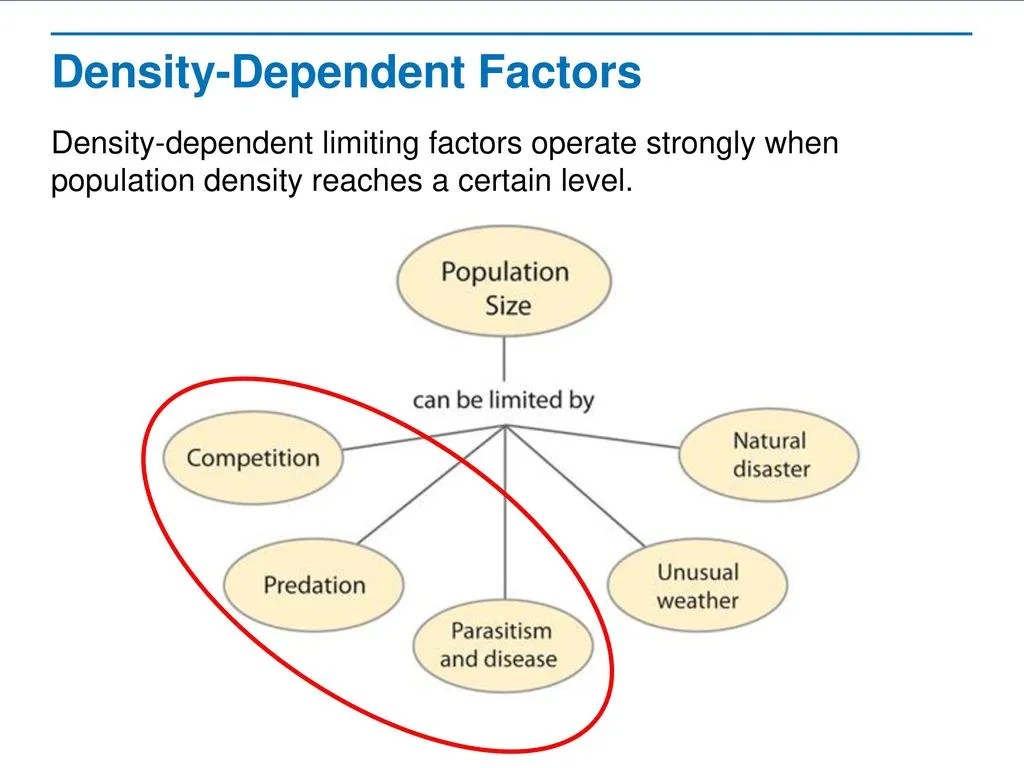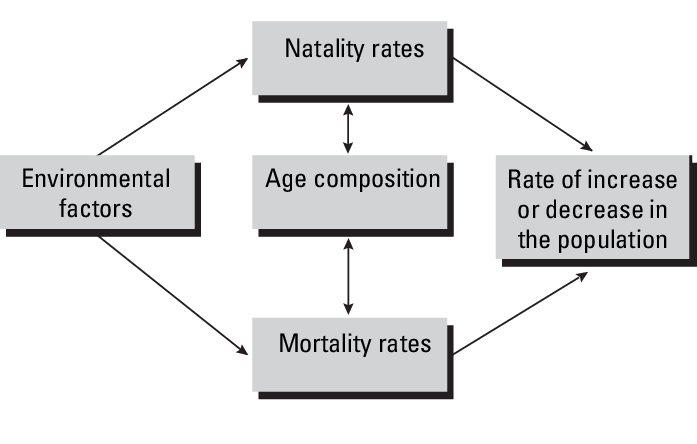Effect of Density of Populations Study Guide
Introduction:
Many variables restrict the quantity and expansion of the population. Some of them are density-dependent, while others are not. The increase in population increases the density, leading to scarcity of resources. This leads to competition in the ecosystem, which impacts survival and reproduction. Let’s know more about what affects population density.
Factors related to density
Density independent limiting factor:
Independent of population density, density-independent factors influence the per capita growth rate. Examples include natural calamities, such as forest fires.
Diverse types of limiting variables can combine in intricate ways to generate different patterns of population expansion. Some populations exhibit cyclical oscillations, in which the size of the population fluctuates in a predictable pattern.
Density-dependent limiting factor:
With rising population density, density-dependent limiting factors cause a population’s per capita growth rate to change—typically, to decline. Competition among members of a population for scarce food is one example.
In ecology, a density-dependent factor, also known as a regulatory factor, is any force that influences the size of a population of living creatures in response to population density (the number of individuals per unit area).
Rather than physical or chemical phenomena, biological events are frequently the source of density-dependent variables. Because of their ability to keep population density within a small range of values, density-dependent variables are frequently referred to as regulating factors.
The majority of density-dependent limiting variables are biotic—that is, they are connected to live organisms—rather than physical aspects of the environment.
The following are some instances of density-dependent limiting factors:
- Competition: When a population reaches a high density, more organisms compete for the same limited resources. Competition for food, water, shelter, mates, light, and other resources required for life and reproduction might occur.
- Predation: Predators may attract higher-density populations that would not bother with a sparse population. When these predators devour population members, they reduce the population’s size while potentially increasing their own. This can result in cyclical patterns that are intriguing to look at.
- Infections and parasites: When more people live in the same location, the disease is more likely to spread and result in mortality. In these settings, parasites are also more prone to spread.
- The build-up of waste: High population densities can lead to the build-up of toxic waste products, killing individuals or making reproduction difficult, limiting population increase.
Behavioral or physiological changes in the creatures that make up the population can also be examples of density-dependent control.
Lemmings, for example, respond to excessive population density by departing in large numbers in pursuit of a new, less congested home. Because the lemmings occasionally drown while attempting to cross bodies of water, this procedure has been misconstrued in popular culture as a form of mass suicide.
Carrying capacity:
- In biology and environmental science, carrying capacity is the maximum number, density, or biomass of a population that a specific area can support sustainably.
- The species population size is limited by environmental factors like adequate food, shelter, water, and mates. If these needs are not met, the population will decrease until the resource rebounds. Every species has a carrying capacity, even humans.
- The carrying capacity is different for each species in a habitat because of that species’ particular food, shelter, and social requirements. Of all the above, food availability is an important variable as it affects the population size of the species.
Population size and density:
- To investigate a population’s demographics, we’ll need to start with some baseline data.
- One is the population size, which is simply the number of people in the population.
- Another factor is population density, which refers to the number of people living in a given area or space.
- Size and density are crucial in explaining the present state of the population and, perhaps, generating forecasts about how it will evolve in the future:
- Larger populations are more likely to be stable than smaller populations because they have more genetic variety and hence more opportunity to adjust to environmental changes through natural selection.
- A low population density in which sparsely distributed organisms may have a harder time finding a partner to reproduce with than a high-density one.
Factors affecting population growth:
- The population growth rate is how a population grows over time.
- A positive growth rate indicates a population increase. A negative growth rate indicates that it is slowing down.
- The birth rate and the mortality rate are the two primary elements influencing population growth.
- People moving into the population from another location (immigration) or leaving the population for another area (exodus) might have an impact on population increase (emigration).
Conclusion:
- Population size, the number of organisms in a given area or volume, and population density, or the number of organisms per unit area or volume, are two major indicators of a population’s size. Ecologists frequently use quadrats and the mark-recapture method to determine population size and density.
- With rising population density, density-dependent limiting factors cause a population’s per capita growth rate to change—typically, to decline. Competition among members of a population for scarce food is one example.
- When a population reaches a high density, more organisms compete for the same limited resources. Competition for food, water, shelter, mates, light, and other resources required for life and reproduction might occur.
FAQs:
1. How does the density of a population affect competition?
The density-dependent limiting element is competition. The more people live in a certain location, the faster the available resources are depleted. When fewer resources are available, there is more competition for those resources.
2. What are the effects of low population density?
Low densities may trigger an extinction vortex, resulting in even lower fertility.
3. Which of the following factors affecting population growth is density-dependent?
Disease, competition, and predation are all density-dependent issues. Factors dependent on population density might have a positive or negative relationship with population size. These limiting constraints have a positive connection with population size, rise with population size and limit growth as population size grows.
4. How does population density differ from population size?
The number of people in a population is referred to as population size. The average number of people per unit of area or volume is known as population density.
5. What are the 4 factors that affect population growth?
The birth rate and the mortality rate are the two primary elements influencing population growth. People moving into the population from another location (immigration) or leaving the population for another area (emigration) might impact population growth.
We hope you enjoyed studying this lesson and learned something cool about the Effect of Density of Populations! Join our Discord community to get any questions you may have answered and to engage with other students just like you! Don’t forget to download our App to experience our fun, VR classrooms – we promise, it makes studying much more fun! 😎
Sources:
- 8.4 Effect of Density of Populations. https://fiveable.me/ap-bio/unit-8/effect-density-populations/study-guide/Zn70P0oeUAlNnbvUEjW3. Accessed 27 Dec, 2021.
- Population Limiting Factors. https://www.nature.com/scitable/knowledge/library/population-limiting-factors-17059572/. Accessed 27 Dec, 2021.
- Population Density. https://www.sciencedirect.com/topics/medicine-and-dentistry/population-density. Accessed 27 Dec, 2021.



